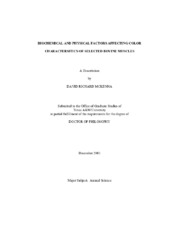| dc.description.abstract | Nineteen bovine muscles were removed from beef carcasses (n = 9). Muscles were trimmed free of fat, cut into 2.54 cm thick steaks, and were packaged in Styrofoam trays with polyvinylchloride overwrap. Steaks were assigned randomly to a day of retail display (0-, 1-, 2-, 3-, 4-, or 5-d). Steaks were evaluated over the course of retail display for objective measures of discoloration (metmyoglobin, oxymyoglobin, L*-, a*-, and b*-values), reducing ability (metmyoglobin reductase activity, resistance to induced metmyoglobin formation, and nitric oxide metmyoglobin reducing ability), oxygen consumption rate, oxygen penetration depth, myoglobin content, oxidative rancidity, and pH. Muscles were grouped according to objective color measures of discoloration. M. longissimus lumborum, M. longissimus thoracis, M. semitendinosus, and M. tensor fasciae latae were grouped as "high" color stability muscles, M. semimembranosus, M. rectus femoris, and M. vastus lateralis were grouped as "moderate" color stability
muscles, M. trapezius, M. gluteus medius, and M. latissimus dorsi were grouped as "intermediate" color stability muscles, M. triceps brachi - long head, M. biceps femoris,
M. pectoralis profundus, M. adductor, M. triceps brachi - lateral head, and M. serratus ventralis were grouped as "low" color stability muscles, and M. supraspinatus, M. infraspinatus, and M. psoas major were grouped as "very low" color stability muscles. Generally, muscles of high color stability had high resistance to induced metmyoglobin formation, nitric oxide reducing ability, and oxygen penetration depth and possessed low oxygen consumption rates, myoglobin content, and oxidative rancidity. In contrast, muscles of low color stability had high metmyoglobin reductase activity, oxygen consumption rates, myoglobin content, and oxidative rancidity and low resistance to induced metmyoglobin formation, nitric oxide metmyoglobin reducing ability, and oxygen penetration depth. Data indicate that discoloration differences between muscles are related to the amount of reducing activity relative to the oxygen consumption rate. | en |


